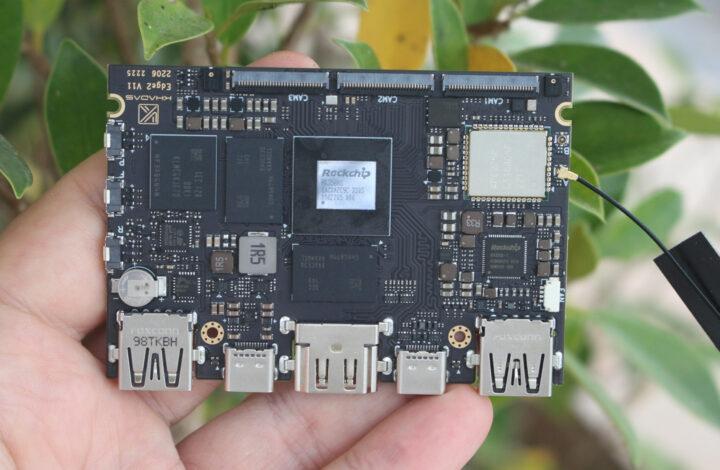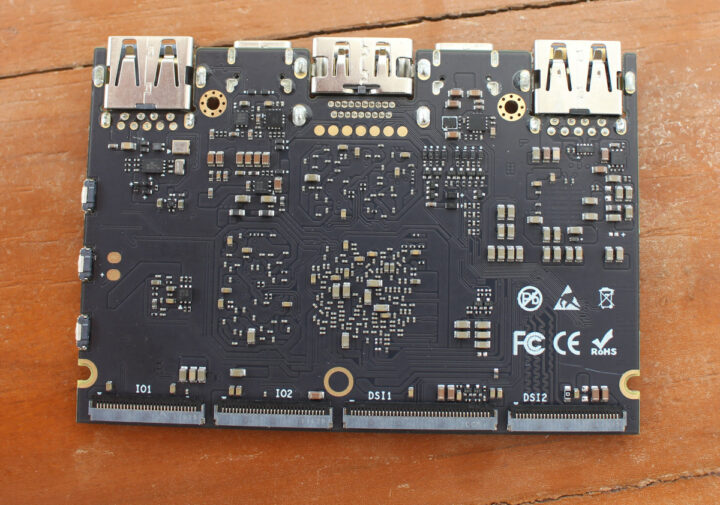As noted in the Khadas VIM1S announcement, the company is also preparing to launch the Khadas Edge2 single board computer with a Rockchip RK3588S octa-core Cortex-A76/A55 processor and a thickness of just 5.7mm (before a low-profile heatsink is installed).
The new board follows a similar form factor as the original Khadas Edge board powered by a Rockchip RK3399 processor, except the edge connector is gone, so it can’t be used as a system-on-module anymore, but remains the thinnest and one of the most powerful Arm SBCs so far.
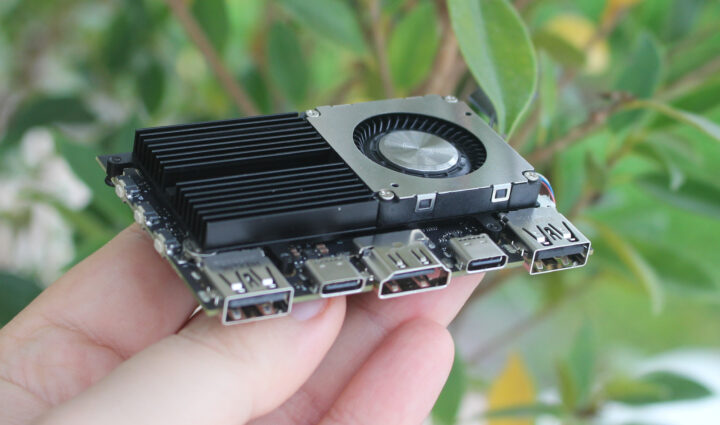
Khadas Edge2 Basic/Pro specifications:
- SoC – Rockchip RK3588S
- CPU – Octa-core processor with four Cortex-A76 cores @ 2.25 GHz, four Cortex-A55 cores @ 1.8 GHz
- GPU – Arm Mali G610MC4 GPU
- AI accelerator – 6TOPS NPU
- VPU
- 8Kp60 10-bit H.265 decoder, 4Kp60 AV1 video decoder
- 8Kp30 H.264/H.265 video encoder
- MCU – STMicro STM32G031K6 Arm Cortex-M0+ microcontroller @ 64 Mhz for power management and boot selection (eMMC or SPI flash)
- System Memory and Storage
- Khadas Edge2 Basic – 8GB LPDDR4x @ 2112 MHz and 32GB eMMC 5.1 flash
- Khadas Edge2 Pro – 16GB LPDDR4x @ 2112 MHz and 64GB eMMC 5.1 flash
- 32SPI flash for OOWOW system
- Video Output
- HDMI 2.1 up to 8Kp60 with HDR, CEC, DSC 1.2a, and HDCP 2.3
- USB-C DisplayPort 1.4 up to 4Kp60
- 30-pin 4-lane MIPI DSI connector up to 4Kp60
- 40-pin 4-lane MIPI DSI connector up to 4Kp60 adding I2C and GPIO signals required for touch panel support
- Four independent displays supported (TBC)
- Audio – Stereo digital microphones, digital audio output via HDMI and USB-C
- Camera I/F – 3x 4-lane MIPI CSI connectors
- Connectivity – Dual-band 802.11 ax/ac/a/b/g/n WiFi 6 2T2R and Bluetooth 5.0 via Ampak AP6275P module, two antennas
- USB
- 1x USB 3.1 Type-A port, 1x USB 2.0 Type-A port
- 1x USB 3.1 Type-C port for data, DisplayPort Alt mode, and USB PD support
- 1x USB Type-C port for power only (USB PD)
- Expansion
- 2x 30-pin IO connectors
- CPU signals: I2C, UART, SPI, SDMMC, I2S, ADC, PWM, USB
- MCU signals: SWDIO, SWCLK, UART
- 7x pogo pads with USB, UART, 5V, GND
- 2x 30-pin IO connectors
- Misc
- 4-pin PWM fan header
- KXTJ3-1057 3-axis accelerometer
- 3V RTC battery
- 2x RGB LEDs
- 3x buttons (Reset, Func, and Power)
- Power Supply
- USB Type-C ports with USB PD support
- XPWR pads for an external power button
- Dimensions – 82 x 57.5 x 5.7 mm (without heatsink), about 11mm thick with heatsink and fan.
- Weight – 25 grams
- Certifications – RoHS, CE, FCC, TELEC, KC
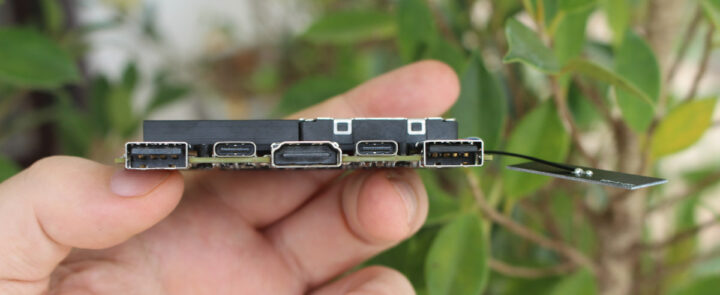
Making a 5.7mm ultra thin SBC means you have to do without perks such as Ethernet or a typical female GPIO header, although those can be added through a USB dock or the Edge2 IO extension board. There’s no microSD card socket either. That’s probably why Khadas has the VIM family with all of those features such as the recently launched Khadas VIM4.
The company provides Ubuntu 22.04 and Android 11/12 images with Linux 5.10 that can be installed through the OOWOW system that provides a menu to download and install the images from Khadas server. Khadas also highlights the Fenix one-click script for building Linux distributions.
I’ve reviewed the Khadas Edge2 Pro SBC with Ubuntu 22.04, and as expected, performance is similar to the Rockchip RK3588-powered ROCK5 Model B board, but Linux support has already improved since my ROCK 5B preview in July. You can also check out the Android 12 review, especially if you are interested in an OS that supports hardware video decoding and 3D graphics acceleration.
Update: September 20, 2020. Khadas Edge2 has launched for $229.90 and up.
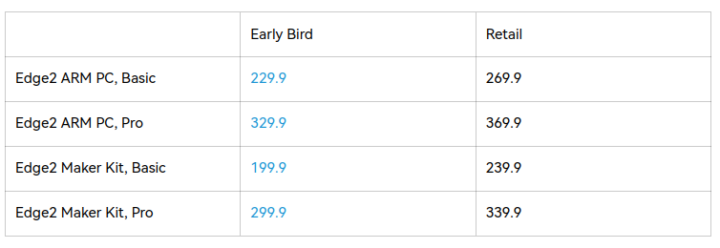
Khadas promises to ship the Edge2 Maker Kits ship within 2 days once the order is confirmed, and Edge2 ARM PCs will ship on or before mid-December 2022.

Jean-Luc started CNX Software in 2010 as a part-time endeavor, before quitting his job as a software engineering manager, and starting to write daily news, and reviews full time later in 2011.
Support CNX Software! Donate via cryptocurrencies, become a Patron on Patreon, or purchase goods on Amazon or Aliexpress


